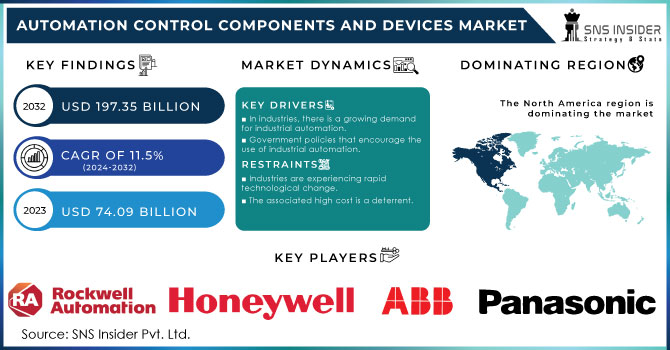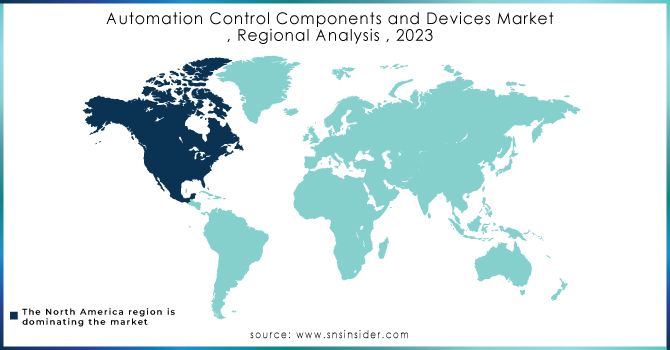Automation Control Components and Devices Market Report Scope & Overview:

Get more information on Automation Control Components and Devices Market - Request Sample Report
The Automation Control Components and Devices Market Size was valued at USD 74.09 billion in 2023 and is expected to reach USD 197.35 billion by 2032 and grow at a CAGR of 11.5% over the forecast period 2024-2032.
Industrial automation is the use of control systems, such as computers and other IT systems, to control various processes in an industry in order to free up human capital. Automation improves output rate and efficiency while lowering production costs by integrating advanced and integrated technology. The increased adoption of smart systems, components, and smart machinery and equipment for the improvement of processes through automation and self-optimization has resulted in the creation of smart factories for planning, supply chain logistics, and product development, thus increasing the Automation Control Components and Devices Market Trends. Several industrial businesses are aiming to become smart factories. Government initiatives to promote industrial automation, the adoption of emerging technologies such as IoT and AI in industrial environments, an emphasis on industrial automation and optimal resource utilisation, and fiscal policies devised by regional financial institutions to keep manufacturing facilities afloat in the midst of the COVID-19 crisis are among the factors driving the growth of the Automation Control Components and Devices Market.
MARKET DYNAMICS:
KEY DRIVERS:
-
In industries, there is a growing demand for industrial automation.
-
Government policies that encourage the use of industrial automation.
RESTRAINTS:
-
Industries are experiencing rapid technological change.
-
ongoing upkeep and upgrades
-
The associated high cost is a deterrent.
OPPORTUNITIES:
-
Development In Industrial Robotics.
CHALLENGES:
-
This will be covered under the final version of the report.
IMPACT OF COVID-19:
Lockdowns implemented in a number of countries since the outbreak of COVID-19 have had a negative impact on the Automation Control Components and Devices Market Size and Automation Control Components and Devices Market Share. To combat the epidemic, several countries have ordered the shutdown of all manufacturing plants. Because of the epidemic, all imports and exports of non-essential products have been prohibited, which has had a significant impact on the electronics industry. The outbreak has had an impact on various businesses' production operations, including the automobile and electronics industries. In contrast, demand is expected to recover in the coming months and expand in the coming years. Robots are expected to gain popularity in restaurants and bars, reducing human interaction and spreading COVID-19. As a result, there will be an increase in demand for automation control components and devices. The negative impact of COVID-19 will be mitigated in the long run, and demand for automation control components and devices will increase in the coming years. The growth of the automation control components and devices market is being driven by government initiatives encouraging the implementation of industrial automation, as well as rising demand for industrial automation across industries.
Based on type, the automation control components and device market are segmented into Relays/Couplers, Switches, and Connectors. Based on application, the automation control components and device market are segmented into Automotive, Oil & Gas, Mining & Metals, Aerospace & Aviation, Manufacturing, Energy & Power, Electronics & semiconductors, and Military Defense.
MARKET SEGMENTS:
BY TYPE
-
Relays/Couplers
-
Switches
-
Connectors
BY APPLICATION
-
Automotive
-
Oil & Gas
-
Mining & Metals
-
Aerospace & Aviation
-
Manufacturing
-
Energy & Power
-
Electronics & Semiconductor
-
Military Defense
REGIONAL ANALYSIS:
North America dominated the market during the previous forecast period, but Asia-Pacific is expected to grow at the fastest rate throughout the forecast period. The region's growing acceptance of automation control components and devices is aided by the region's strong demand for automation components in the oil and gas, metals, and mining industries, the presence of major manufacturers and the introduction of digital technologies. These factors have a significant impact on manufacturers' ability to develop automation control components and devices.

Get Customized Report as per your Business Requirement - Request For Customized Report
REGIONAL COVERAGE:
-
North America
-
USA
-
Canada
-
Mexico
-
-
Europe
-
Germany
-
UK
-
France
-
Italy
-
Spain
-
The Netherlands
-
Rest of Europe
-
-
Asia-Pacific
-
Japan
-
south Korea
-
China
-
India
-
Australia
-
Rest of Asia-Pacific
-
-
The Middle East & Africa
-
Israel
-
UAE
-
South Africa
-
Rest of Middle East & Africa
-
-
Latin America
-
Brazil
-
Argentina
-
Rest of Latin America
-
KEY PLAYERS:
The key players in the automation control components and device market are Panasonic Corporation, ABB Limited, Delta Electronics, Encoder Products Company, Honeywell International Inc., Omron Corporation, Phoenix Contact, Schneider Electric SE, Rockwell Automation, and Siemens AG.
| Report Attributes | Details |
|---|---|
| Market Size in 2023 | US$ 74.09 Billion |
| Market Size by 2032 | US$ 197.35 Billion |
| CAGR | CAGR of 11.5% From 2024 to 2032 |
| Base Year | 2023 |
| Forecast Period | 2024-2032 |
| Historical Data | 2020-2022 |
| Report Scope & Coverage | Market Size, Segments Analysis, Competitive Landscape, Regional Analysis, DROC & SWOT Analysis, Forecast Outlook |
| Key Segments | • By Type (Relays/Couplers, Switches, Connectors) • By Application (Automotive, Oil & Gas, Mining & Metals, Aerospace & Aviation, Manufacturing, Energy & Power, Electronics & Semiconductor, Military Defense) |
| Regional Analysis/Coverage | North America (USA, Canada, Mexico), Europe (Germany, UK, France, Italy, Spain, Netherlands, Rest of Europe), Asia-Pacific (Japan, South Korea, China, India, Australia, Rest of Asia-Pacific), The Middle East & Africa (Israel, UAE, South Africa, Rest of Middle East & Africa), Latin America (Brazil, Argentina, Rest of Latin America) |
| Company Profiles | Panasonic Corporation, ABB Limited, Delta Electronics, Encoder Products Company, Honeywell International Inc., Omron Corporation, Phoenix Contact, Schneider Electric SE, Rockwell Automation, and Siemens AG. |
| Key Drivers | • In industries, there is a growing demand for industrial automation. • Government policies that encourage the use of industrial automation. |
| RESTRAINTS | • Industries are experiencing rapid technological change. • ongoing upkeep and upgrades |

